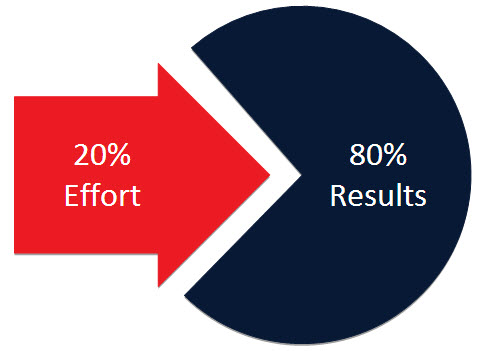Many business owners, managers and salespeople tell us that eighty-percent of their business comes from twenty-percent of their customers. The Pareto principle…
As you may know, the “Pareto Principle,” also known as the 80/20 rule, states that, for many events, roughly 80% of the effects come from 20% of the causes. In other words, 20% of our effort yields 80% of the results.

Whether this perspective accurately describes your business situation or not, it is still likely that some concentrated percentage of your customer base generates the majority of your sales revenue. Similarly, some concentrated or relatively small percentage of your current and prospective customers most likely makes-up the majority of your new business pipeline.
Given these facts, it is wise to create a “Key Account Program,” which is simply an organized sales and marketing strategy that will ensure a sufficient amount of attention is being given to the concentrated group of customers and prospects that will, most likely, make-up the majority of your organization’s sales revenue and growth over the next twelve to twenty-four months.
Please note that we call this plan a “key account” program, not a “key customer” program, because it is important to pay an appropriate amount of attention (extra attention!) to these select customers and prospects alike.
Key Objectives: Retention, Incremental Business & New Business
- The objective of a key account program is to retain your best customers, increase penetration within customers with whom your organization has only a small percentage of the potential business, and to win over high-potential prospects. Consider the following three points:
- A customer who generates a relatively large percentage of your organization’s business is, obviously, of great value. The business relationship must be nurtured, and every effort must be made to retain this customer. In addition, if this customer generates a large amount of revenue for your organization, then it’s almost a sure thing that your competitors are working hard to earn that business too! Thus the extra attention.
- A customer with whom your organization does a small or moderate amount of business, but who has the potential to become a much larger customer must be treated with extra diligence as well, as this customer is a good source of potential sales growth. Since it is typically easier to leverage a current, albeit smaller-scale, relationship than to start from scratch, the extra sales effort is justifiable.
- A prospective customer with high-potential – possibly one of your biggest competitor’s top ten customers – is worthy of a more focused and larger-scale sales effort. The “payoff” for success might be greater in terms of both sales dollars and competitive position, thus justifying the extra effort.
Key Activities:
- Target a manageable number of engaged (top) customers, sub-optimally engaged customers (those with lots of potential) and high-potential prospects (your competition’s best customers).
- Conduct thorough research to make sure you understand each target’s needs, priorities and emerging needs.
- Conduct thorough research to identify the appropriate contacts within each organization – it’s often best to develop relationships with more than one person within each account. Target people on a “high, deep, and wide” basis for the best results.
- Set time-based activity and results goals for the program. These might include the number of value-added sales calls you plan to make to each group throughout the year, the number of meetings you hope to schedule with prospects, and the dollar amount in incremental sales revenue you hope to gain from the under-engaged customers and high-potential prospects.
- Identify a marketing strategy – you might ask yourself, “Which components of your current collateral will send the right message? What additional pieces or social media posts might you create to support your key account effort? What promotional activities might be appropriate?”
- Identify a sales strategy that is integrated with your marketing plan – be sure to include a comprehensive contact strategy that makes use of all appropriate media (i.e., e-mail, telephone calls, social media, e-marketing, traditional marketing collateral, personal visits or remote meetings, invitations to promotional events, and so on) as well as a plan that will help the key accounts understand the value your organization offers and how your organization can meet their needs.
- Use or create an annualized contact management or organizational system that will help you keep track of your activity and progress.